Be sure to Click LIKE at the bottom of this article, and share it everywhere!!
By Craig Andresen – Right Side Patriots on American Political Radio
 The story of the birth of Jesus, as told in two books in the Bible, is a good story full of hope, and promise. That story eventually gave rise to a major religion, Christianity, and it has been told, and retold for the past couple of thousand years.
The story of the birth of Jesus, as told in two books in the Bible, is a good story full of hope, and promise. That story eventually gave rise to a major religion, Christianity, and it has been told, and retold for the past couple of thousand years.
It’s a story…but it’s a good story.
That story has Jesus being born in a manger, because there was no room at the inn, shepherds, wise men, gifts meant for a King, and so much more. Christians around the world celebrate the story of the birth of Jesus, and hold it dear. There’s nothing wrong with that.
But it is a story that relies on faith rather than on fact…and one should not try to replace the latter with the former.
Let me explain…
Christmas is celebrated on December 25th, because that’s when the date was chosen in 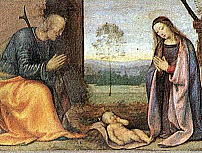 336AD by the Pope, not because that’s the actual date of the birth of Jesus.
336AD by the Pope, not because that’s the actual date of the birth of Jesus.
In fact, we know it’s the wrong date for several reasons. First, there would not have been a census taken, forcing people to travel distances during what would have been Israel’s coldest, and wettest time of the year. Also, as fact, we know that one of the three times in the year when families would travel to observe God’s Holy Days would have been in late September, and for both political, and logistical reasons, if a census were to be taken to count people in the cities of the man’s birth for tax purposes, it would make a great deal of sense to do so when they would be in their home cities.
There are other clues.
The book of Luke tells of shepherds in their fields by night, and that would not have been the case in late December, in late September, yes, but not in late December. There are also passages in the Bible that provide a timeline for Mary’s pregnancy which would have her roughly three months along at the time of the birth of John, who would become John the Baptist to Mary’s cousin Elizabeth, and that timeline would put his birth in mid to late March and that ca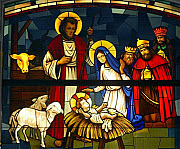 n be derived by tracing the time that Elizabeth became pregnant using descriptions of when her husband attended a traditional Jewish gathering.
n be derived by tracing the time that Elizabeth became pregnant using descriptions of when her husband attended a traditional Jewish gathering.
That the birth of Jesus is celebrated on December 25th is a matter not of faith, not fact, but of tradition, and I’ll get back to that later.
Devout Christians insist that the Bible is the “word of God,” and that every word of it is absolute truth, but that too is a matter of faith, and not fact. As an example of this, let’s again look at the stories regarding the birth of Jesus, one told by Luke, and the other by Matthew. Those are the only two tellings of it in the Bible, and those two stories are remarkably different.
Luke has shepherds visiting the baby Jesus on the night of his birth, and makes no mention whatsoever of the wise men, while Matthew tells the story of the wise men, and never mentions the shepherds. In fact, the two stories also show us conflicting timelines for the birth of Jesus with regard to the year, and they are nearly ten years apart. Obviously, they can’t both be correct, and if every word of the Bible is to be taken as gospel truth, which of the two stories are Christians to favor? Both are written in the Bible, and both have remarkable differences meaning both can’t be gospel truth, and therefore, one cannot take  every word of the Bible as fact. But as faith? That’s a different story, isn’t it?
every word of the Bible as fact. But as faith? That’s a different story, isn’t it?
Now, in Matthew’s version of the story, wise men come to see the baby Jesus. Traditionally, faith tells us there were three of them, but the facts paint a different picture. To be honest, the notion that there were three is derived from the three gifts, but Mark makes no mention of the number at all. Who were they? Well, again, faith presents them as Balthazar, Gaspar, and Melchior, and faith tells us they were Kings, but again, facts must come into play. Matthew never provided any names, nor did he ever refer to them as Kings. So when, and how did their names come about?
Well, as fact, not faith would have it, in the 6th century, literally hundreds of years after the birth of Jesus, Emperor Justinian created the famous mosaics in various churches in the 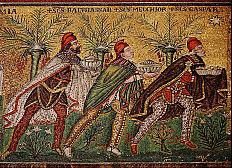 city of Ravenna, Italy, and in one of those churches, the church of Saint Apollonare in Classe, a mosaic of three wise men appears. The Emperor commissioned the piece to include names for them to be displayed below their artistic images, Balthazar, Gaspar, and Melchior.
city of Ravenna, Italy, and in one of those churches, the church of Saint Apollonare in Classe, a mosaic of three wise men appears. The Emperor commissioned the piece to include names for them to be displayed below their artistic images, Balthazar, Gaspar, and Melchior.
The names of the wise men which are now a matter of faith, were, in fact, commissioned by the Emperor of Rome nearly 500 years after the fact.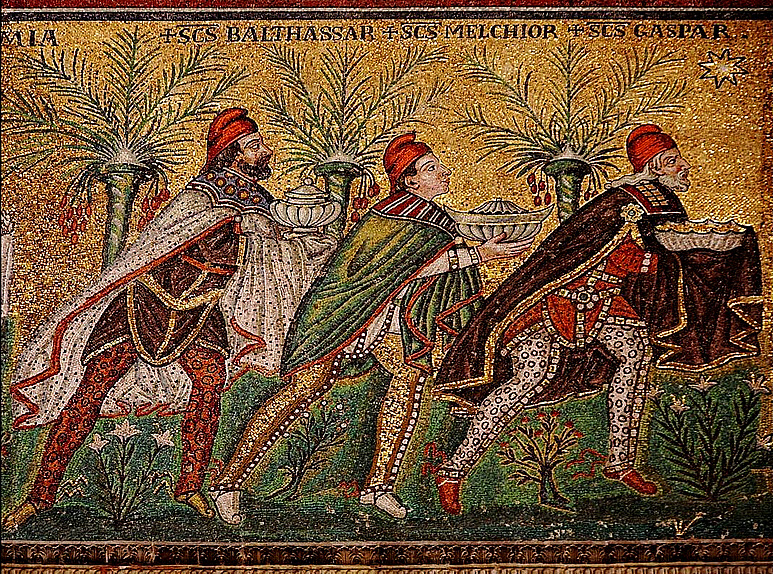
Also, with regard to the wise men, faith would have us believe that they arrived and saw the baby Jesus on the night of his birth, but that is a condensed version of what Matthew relates, and the clue to that is found in that part of the story where King Herod mandates the killing of baby boys due to his paranoia over being replaced by a new King. According to Matthew, Herod demands that all males up to two years of age be killed. Two years? If Herod had known the baby had just been born, as faith dictates, one could understand two weeks, perhaps two months, but not two years. This indicates that the wise men, if they showed up at all, may well not have seen Jesus until he was two years old.
However, having three wise men showing up that very night, and recognizing them by name is a better story.
And how about the inn, where no room could be found thus forcing Mary to give birth in a stable?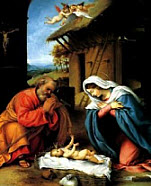
Faith has us believe that after their journey, and with Mary about to give birth, she and Joseph tried to get a room at the inn, but because of the crowd there to participate in the census, the inn was full. At that point, Mary and Joseph had no alternative to spend the night in a lone stable, and that is where Jesus was born.
That really is a compelling story, but…
Let’s first remember why Mary and Joseph were in Bethlehem, for the census, where couples were required to be counted in the hometown of the man of the house. That means that Joseph had family still living in Bethlehem, which was but a small village in those days, and not at all an affluent village at that. The notion that the village had an inn would be much more a matter of faith than fact. What is much more likely, is that Mary and Joseph tried to stay with a member of his family in that village, but homes in that place, in those times, were but hovels. Between other relatives being there for the census, and let’s not forget the thrice annual Jewish festival, chances are pretty good that the house was already packed…not with random guests, but with Joseph’s relatives.
There is also this fact, we know it wasn’t an inn at all, and we know this because of the language barrier between the writer, and whoever translated, and retranslated the story for the better part of a few centuries. In the original texts, what Luke wrote about was a “kataluma,” which has been translated to mean an “inn,” but a “kataluma” by Luke’s recognition would have actually meant, guest quarters, or in today’s parlance, a guest room that was already occupied by some other member of the family.
Most homes in Bethlehem in those days had a grotto next to them, a place of stone shelter where small floc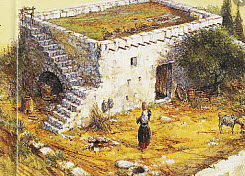 ks of the families livestock would be during the cold, rainy months, but being as that is was what we know as September, that family’s livestock would have been in a nearby field, being tended to by shepherds, which were most likely members of the family. That too would account for the shepherds visit in Luke’s account of the story. They would have known of Mary’s pregnancy, and the impending birth, and curious as to the arrival of a new member of the family, they would have naturally checked in.
ks of the families livestock would be during the cold, rainy months, but being as that is was what we know as September, that family’s livestock would have been in a nearby field, being tended to by shepherds, which were most likely members of the family. That too would account for the shepherds visit in Luke’s account of the story. They would have known of Mary’s pregnancy, and the impending birth, and curious as to the arrival of a new member of the family, they would have naturally checked in.
While there is no mention by Luke of the shepherds being related to Joseph, we must also remember that, as a matter of fact, not faith that the original transcripts went through hundreds of years of manipulation by oral story tellers, scribes and Popes and Kings before ever becoming the matters of faith we know them as today. Turning relation into random shepherds on a divine quest is a much more compelling story, than would be the simple facts.
So, why December 25th, when we know, as did both Luke and Matthew, a much more accurate date?
Well, if what we can discern from the writings regarding the true date of the birth of Jesus being in what we now consider late September, that means that his conception took place nine months before, in late December of the previous year, and we do know from other texts outside of the Bible that estimates of the date of conception held more importance to the people of those times than did the dates of birth, but that’s not really it.
As a matter of fact, early Christians, at least in the 1st and 2nd centuries mocked any 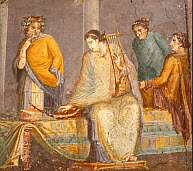 celebration of birth dates, as that was something the Romans did, but the Romans did it in concert with members of the religion that dominated their world in those days, paganism. Pagans celebrated birthdays, and other events such as a solstice, and the nearest solstice to late September would be the one in late December. Starting in the 4th century, Christianity became the primary religion of Rome, and the Romans, wanting to convert pagans, started to use the dates of the pagan winter solstice, and a celebration of birth to woo the pagans into making the switch.
celebration of birth dates, as that was something the Romans did, but the Romans did it in concert with members of the religion that dominated their world in those days, paganism. Pagans celebrated birthdays, and other events such as a solstice, and the nearest solstice to late September would be the one in late December. Starting in the 4th century, Christianity became the primary religion of Rome, and the Romans, wanting to convert pagans, started to use the dates of the pagan winter solstice, and a celebration of birth to woo the pagans into making the switch.
Various attempts by various factions of early Christians to link the conception of him to the date of his death came and went, but December 25th stuck, because it initially gave the pagans a different reason to celebrate aside from their traditional winter solstice celebrations, and thus a new tradition was born.
This all leads to some very interesting questions. Why have the stories of the birth of Jesus been so conflated, altered, and embellished? Why are the only two versions of it contained in the Bible so different? And why has tradition based in blind faith won out over what is shown by the facts that can be verified?
Because, despite the politics of that time, and centuries of politics since, despite the barriers created by different languages and transcriptions, and even after time frames were manipulated to entice Roman pagans to abandon their ways for something new…Christmas, even in spite of Christianity itself at times, Christmas has become a traditionally special time.
Had Luke and Matthew stuck to the facts, had all those involved through the centuries just stuck to the facts, the story would have been relatively unremarkable, mundane, and most likely forgotten in decades rather than lasting for two thousand plus years, but those facts, as plain and as simple as they are, became the basis for elaborations, and a foundation 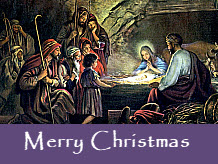 for faith. This isn’t a faith vs facts thing, it’s more of an embellished by faith, predicated on facts thing, literary license and all.
for faith. This isn’t a faith vs facts thing, it’s more of an embellished by faith, predicated on facts thing, literary license and all.
The facts alone would have been lost over time, but dress it up with faith and what have you got?
A story…a very good story.
Copyright © Craig Andresen/thenationalpatriot.com 2019/ All rights reserved
*************************************************************************************************
For more political commentary please visit my RIGHT SIDE PATRIOTS partner Diane Sori’s blog, The Patriot Factor to read her latest article, A Military Christmas…Past and Present
*************************************************************************************************





Very interesting. Thank you, Craig. I read all your pieces and send them out to many others. I enjoy them immensely.
We had Richard Booker visit with a teaching that stated that the baby was born in a bottom floor of a tower where the animals for sacrifice in the temple were kept. That and the manger was a stone area carved out.The tradition of swaddeling the newcborn lambs, whose hoofs were not to touch the floor to keep them clean, was reflected in swaddling the baby also, symbolically “the lamb”.
Adrienne Godre, those are some of those traditional embellishments that I wrote of in the article. There simply isn’t any way to prove any of it. We know what we know as facts, about the way of life in that place in that time…faith has embellished it…made it into a good story.